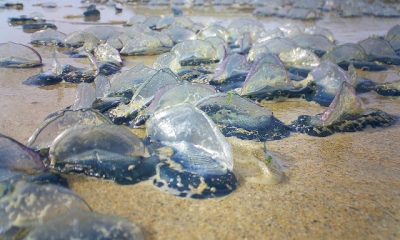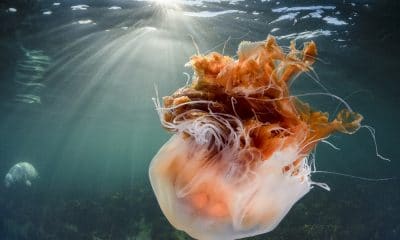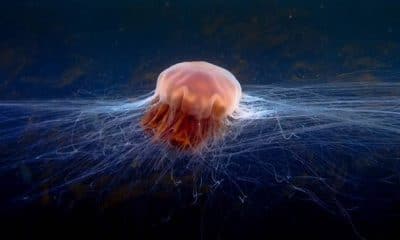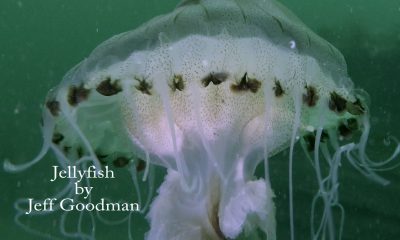News
Scientists investigate global spread of stinging jellyfish
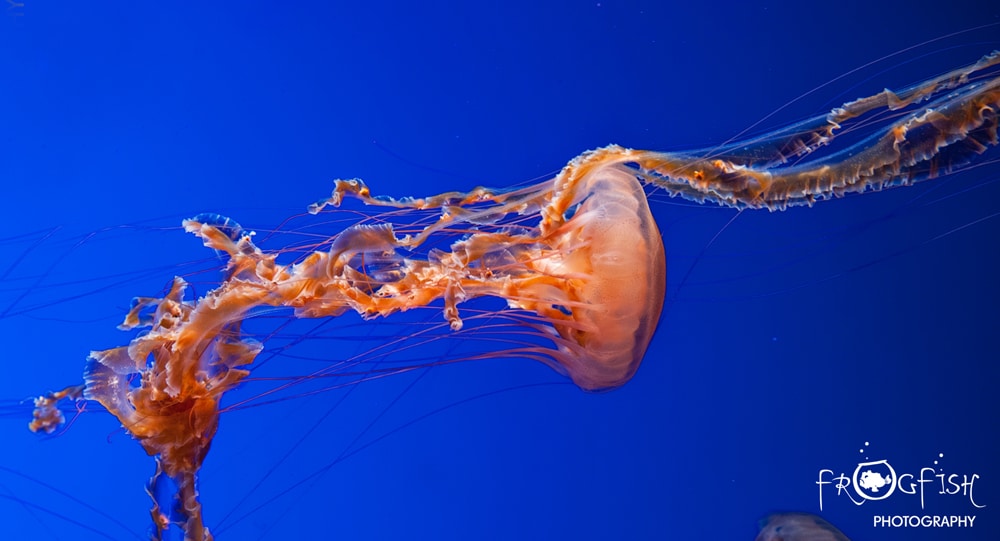
“Get it off of me! Get it off of me!” shrieked Mary Carman, a marine ecologist at Woods Hole Oceanographic Institution (WHOI) as she flailed knee deep in the bath-like water of Farm Pond on Martha’s Vineyard.
She was observing tunicates (also known as sea squirts) in the quiet coastal pond, garbed in a full wetsuit and snorkeling gear as she hovered through the shallow grassy water. She was well covered except for parts of her face, including her lips which became a landing spot for a clinging, stinging jelly.
“The sting was one of the most painful things I’ve experienced in my life—I liken it to being injected by five hypodermic needles simultaneously,” she said.
Despite the ensuing pain and “two days of nausea,” Carman has been back in Farm Pond on several occasions. But instead of looking at tunicates, she’s been collecting samples of the toxic jellies, scientifically known as Gonionemus sp. In the past several years, she, along with WHOI biologist Annette Govindarajan and their colleagues, has been tracking these clinging jellyfish which, according to a new study, appear to be expanding throughout the Cape and Islands region.
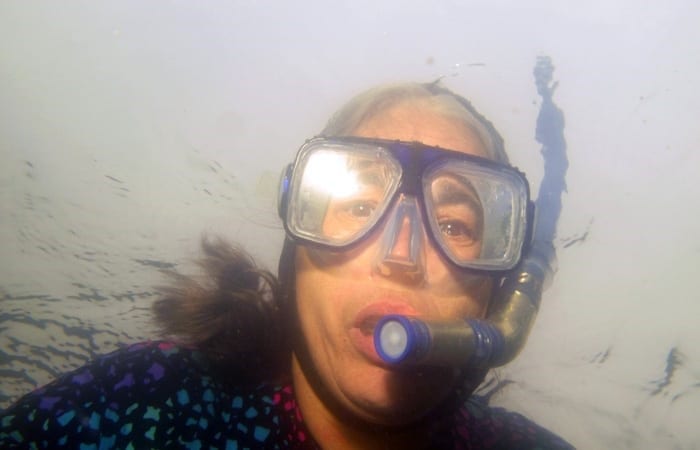
Secret hitchhikers
The toxic invader looks like a clear, medium-sized coat button collared with several dozen threadlike tentacles. The tentacles sport adhesive-like pads that allow the animal to stick to eelgrass, seaweeds—and yes, lips too—before emitting venomous neurotoxins that can cause extreme pain, breathing difficulties, and blisters. Their origin is unclear. The jellyfish were abundant in a few New England locations, including Eel Pond in Woods Hole, Mass. in the late 1800s until about 1930, when they all but disappeared after a slime mold decimated most of the region’s eelgrass. Carman and Govindarajan are unaware of any regional reports of stings during this period, although stings had been reported from the Sea of Japan.
The jellies resurged on Cape Cod in the 1990s, with the first documented sting report occurring in 1990 in Waquoit Bay. The first documented Martha’s Vineyard sting occurred in 2006 and it appears that the population has been expanding there ever since. According to the study, in one of the newly colonized sites (Edgartown Great Pond), jellyfish were clustered in a cove with a public boat ramp, suggesting that transport on boat hulls could be promoting their distribution around the island. “The jellyfish have life cycle stages that can be less than a millimeter in size and that adhere to surfaces, so they could very easily be hitchhiking on boats without being seen,” said Govindarajan.
The study points to another factor possibly contributing to the spread: cloning. This particular species is known to have the ability to make multiple copies of itself during various stages of asexual reproduction. “As we analyzed the sex ratio of our samples, we discovered that all of the jellies collected at Edgartown Great Pond were male,” said Govindarajan. “This is consistent with the possibility that this particular population is clonal, and that asexual reproduction is contributing to their spread. But we need more information on the dynamics of these stages, such as how long they can persist and what factors trigger them to produce jellyfish.”
Across the pond
According to the researchers, the toxic jelly outbreak isn’t just a local phenomenon: the animals have been found along the coasts of Russia, Japan, China, the Mediterranean, Argentina, and most recently, along Sweden’s rocky west coast, where just last summer, a number of bathers were stung. That outbreak was documented in another study in which Govindarajan and colleagues from Sweden compared DNA sequences of clinging jellies collected at the site with those found along the US East Coast and other parts of the world, and discovered some genetic similarities.
“We found some common genetic variants occurring in disparate locations where stings have been reported,” said Govindarajan. “We’re not sure what’s triggering these toxic outbreaks – multiple factors may be at play, but human-mediated transport of the tiny, cryptic life stages may have a role globally as well as locally.”
Björn Källström, a marine biologist at Gothenburg Marine Biological Laboratory and co-author of the study, says underwater photographers have observed clinging jellies in Sweden in the past, but last summer marked the first time that people there reported being stung.
“One factor may have been the really hot and dry summer we had last year, which caused water temperatures at the site to surge 3°C above seasonal averages,” he said. “Previous studies have suggested that when ocean temperatures are warmer, clinging jellyfish production is triggered. And when they increase in numbers, more people are likely to encounter and get stung by them.”
Avoiding hot spots
With a host of possible factors at play—anthropogenic transport, warmer ocean temperatures, and the comeback of eelgrass—Govindarajan, Carman, and their international colleagues plan to continue studying the stinging creatures to better understand the intricacies of the spread.
Källström feels that in the near term, the research can help bathers avoid areas where the jellies are likely to disperse.
“Climatologist have predicted another hot, dry summer in Sweden, which means that we could see another outbreak over the next few months,” he said. “And this time, we suspect it may spread to other locations along the coast. So, we’ll be developing models to help predict where the jellies may go, so people know which areas to stay away from.”
Govindarajan agrees. “The more we can learn about how they’re expanding and the types of conditions the jellies are thriving in, the more we’ll be able to identify where the hot spots are and educate the public.”
Gonvindarajan says the community can also help the monitoring effort by reporting sightings of clinging jellies to jellyfish@whoi.edu—although she cautions people to be careful, and to not handle the jellies.
For more information about the work of WHOI please visit their website by clicking here.
Gear News
Introducing the TR-80, IR-50 and CS-30 Regulators from DYNAMICNORD

Whether you are a beginner or a professional diver – with the three new main regulators from DYNAMICNORD, everyone will find their favourite regulator. They all look super stylish.
Excellent performance with the TR-80
Quality and performance are the be-all and end-all for regulators. It is not for nothing that the TR stands for Tec Reg. The innovative design of the TR-80 guarantees absolute reliability – even in ice-cold waters.

Perfect breathing effort at 0.8 J/l / certified for diving in waters below 10 degrees / structural design made of solid brass for best cold protection / membrane-compensated design with dry seal of the first stage / reduced exhalation effort thanks to optimized exhalation membrane and bubble deflector / adjustable Venturi (dive/predive) and adjustment knob for individual inhalation comfort / innovative design of the front cover prevents free-flow in strong currents or when diving with scooters / design made of sandblasted brass, matt chrome finish / 2 HP and 4 LP outlets / mouthpiece made of high-quality, anti-allergic silicone for maximum comfort.


Amazing underwater adventures with the IR-50
The IR-50 is the top regulator for advanced and experienced divers. Natural breathing is the essence of this regulator.

Ideal breathing effort at 0.8 J/l /certified for diving in waters below 10 degrees / compensated membrane / adjustable venturi (dive/predive) and adjustment knob for individual inhalation comfort/ outlet valve and deflector for minimum exhalation effort and reduction of bubbles on the face / design made of sandblasted brass, matt chrome finish / 2 HP and 4 NP outlets / mouthpiece made of high-quality, anti-allergic silicone for maximum comfort.


The Workhorse – our CS-30
For diving centres and diving beginners – the workhorse stands for strong construction, reliability and robustness. Perfect for your training.

Optimal breathing effort at 0.8 J/l /recommended for diving in waters above 10 degrees / non-compensated piston / adjustable venturi (dive/predive) / outlet valve and deflector for minimum exhalation effort and reduction of bubbles on the face / design made of sandblasted brass, matt chrome finish / 1 HP and 3 NP outlets / mouthpiece made of high-quality, anti-allergic silicone for maximum comfort.


Octopus OP-30
The OP-30 is the ideal addition to all DYNAMICNORD regulators. It is identical in construction to the CS-30.

The TR-80, IR-50, CS-30 (DIN & INT) regulators and the Octopus OP-30 are available from DYNAMICNORD dealers and in the online store.
DYNAMICNORD – Your Outdoor Companion.
Marine Life & Conservation
Paul Watson Released as Denmark Blocks Japan’s Extradition Bid

Renowned anti-whaling activist Paul Watson has been released from custody in Greenland after spending five months in detention. Denmark’s Justice Ministry rejected Japan’s request for his extradition, citing insufficient guarantees that his time already served in custody would be credited against any potential sentence.
The 74-year-old Canadian-American was arrested on July 21 in Nuuk, Greenland’s capital, when his ship docked to refuel. His arrest was based on a 2012 Japanese warrant related to a 2010 encounter in Antarctic waters. Japan alleged Watson obstructed operations and caused damage to a whaling research ship during efforts to disrupt illegal whaling. Watson has consistently denied these claims, maintaining his commitment to marine conservation.
Denmark, which oversees extradition matters for Greenland, concluded that while the legal conditions for extradition were met, the lack of assurances from Japan regarding time-served credit made extradition untenable.
In a video shared by his foundation, Watson expressed gratitude and relief, saying, “After five months, it’s good to be out… and good to know they’re not sending me to Japan.” He added that the most difficult part of his time in custody was being separated from his two young sons.
Watson is a pioneering figure in marine conservation, known for founding the Captain Paul Watson Foundation in 2022 after decades of activism with the Sea Shepherd Conservation Society. His bold efforts to defend marine life have earned him widespread support, including from celebrities and conservationists. His work has also been featured in the acclaimed reality TV series Whale Wars.
Watson’s lawyer, Jonas Christoffersen, praised the decision, stating, “We are happy and relieved that Paul Watson is now free.” He added that Watson is eager to reunite with his family and continue his vital work.
The arrest occurred while Watson’s vessel, the M/Y John Paul DeJoria, was en route to the North Pacific with a team of 26 volunteers to intercept a Japanese whaling ship. His foundation described the arrest as politically motivated and emphasized that Watson’s actions were focused on ending illegal whaling practices.
Japan resumed commercial whaling in 2019 after leaving the International Whaling Commission, asserting that whale meat is a cultural tradition. Conservationists, however, continue to challenge these practices, highlighting their impact on marine ecosystems.
Despite the challenges, Watson remains steadfast in his mission to protect marine life and bring attention to whaling practices. His dedication to ocean conservation has made him a globally respected advocate for the environment.
-

 News2 months ago
News2 months agoIconic SS United States to become the World’s Largest Artificial Reef
-

 News3 months ago
News3 months agoBook Review – 52 Assignments: Underwater Photography
-

 Gear News3 months ago
Gear News3 months agoDYNAMICNORD – New German diving brand enters the British market
-

 News3 months ago
News3 months agoExploring Cenote El Pit: A Diver’s Dream
-

 Gear News3 months ago
Gear News3 months agoTry BARE drysuits (and maybe even win one!) this Friday with Sea & Sea at North West Dive Fest
-

 Marine Life & Conservation3 months ago
Marine Life & Conservation3 months agoBook Review: Coral Triangle Cameos
-

 Blogs2 months ago
Blogs2 months agoDive the Egyptian Red Sea this Autumn with Regaldive
-

 News3 months ago
News3 months ago2024 Ocean Art Underwater Photo Competition Announced



